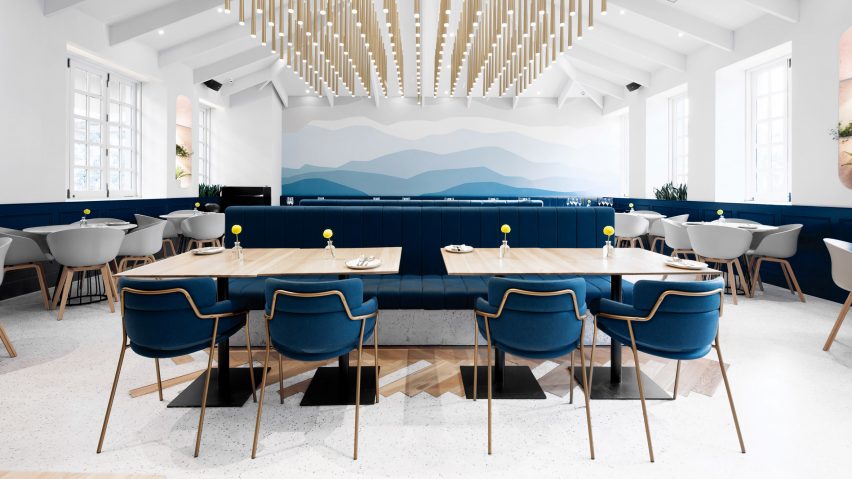An old school building in Shanghai has been transformed by Coordination Asia into a restaurant with social media-optimised decor.
The local architecture and interior design studio overhauled the 19th century building for Gaga restaurants, to create Changning Villa.
"The Gaga restaurants attract a young, well-informed Shanghai crowd that is constantly on a hunt for the new and upcoming. Setting foot into a historic building is not on the top of their list," founder and director of Coordination Asia Tilman Thürmer told Dezeen.
Gaga's target audience are young women who are "fashion-conscious and highly digitally engaged". Healthy eating and living is also increasingly popular with the young Shanghainese crowd, who Thürmer describes as "well informed and very critical".
To attract this clientel Coordination Asia has a secret weapon – a design process that optimises interiors so they can become some of the city's most covetable Instagram backdrops.
"It is not unusual in our projects for us to build mock-ups to control angles for selfies and [check] if the space fits well in the lens of a smartphone camera," revealed Thürmer.
"It's not just that most clients wish for an Insta-friendly design. During the design process our designers used to catch themselves double-checking if their ideas made a good square photo."
Along with social-media-ready neon light installations and rooms designed to crop to the perfect square, the restauranteurs even ran checks to make sure the menu matched the decor before it got approved.
"For the Changning Villa our client tested to see if the interior goes well with its dishes and signature fruit-teas, before signing up on the design," said Thürmer.
Other tech-enabled upgrades integrated into the restaurant design include a system that allows users to order their meal and drinks via WeChat, China's most popular social media app.
Changning Villa sits in the midst of a modern Shanghai, in the shadow of the Raffles City shopping mall. But the building is a relic of Shanghai's colonial past, originally a part of St. Mary’s Hall, a girls school established by American missionaries.
Amongst it's alumni were Eileen Chang, one of China's most influential modern writers, who was a student during the 1930s.
"For the historic Changning Villa we wanted to audience to step into a completely different world when entering through one of the old doorways. The interior’s look and feel had to be fresh, friendly and of casual elegance without compromising the character of the original building."
Coordination Asia retained the doors and classical windows, and as much of the ceilings that hadn't fallen into irreversible disrepair.
Spread over two stories, the new interiors have been painted in minimal palette of white, with accent walls of deep blues and teals, complimenting the navy banquette seats and brass details. Custom lamps and lighting installations on the ceiling bring a contemporary edge to the dining rooms.
Three separate entrances provide access to the downstairs cafe and bar, and the restaurant upstairs. The cafe has the lightest colour-way, whilst the bar area has been decorated in a darker, moodier palette for evening.
Upstairs, the dining room sits under the villa's original gabled roof, which now has a brass lighting installation suspended underneath. In one corner a separate dining area painted in the same petrol-green as the downstairs affords diners a view of the kitchen through a large interior window.
If the visitors to Changning Villa can tear themselves away from ordering their food via an app, photographing it against the perfect backdrop and uploading it to the internet, they may even learn something about the building's past.
"The restaurant staff also went through a training session to be able to briefly tell interested guests about the location, the former function as a school and the writer Eileen Chang," added Thürmer.
Previously, Coordination Asia used a grid of neon tubes to turn a art gallery in Beijing into gym for Nike, and created a kaleidoscopic wedding chapel in Shanghai from 3,000 panes of glass in 65 different shades.

